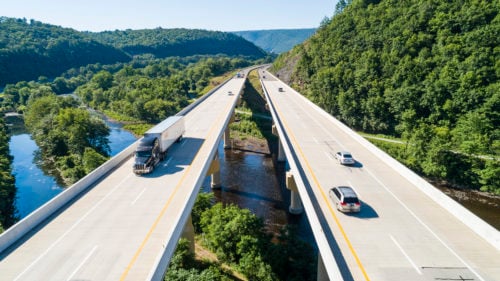Trucking is a vital service for those who depend on non-train, non-plane, and non-ship goods delivery. It has set the stage for humanity to expand over all forms of terrain without starving. Trucking allows people to keep the creature comforts of home in areas other transportation methods just cannot reach.
To maintain its usefulness, trucking has to evolve as the markets that rely on it do. That means going green in the modern age. Reliance on trucking is well-reflected in the value of the trucking industry—more than 600 billion dollars in 2017 alone.
Aerodynamic improvements
Trucks are infamously cube-like, they move through the air like a brick and weigh a ton (several, in fact.) Aerodynamic improvements can help trucks increase their fuel efficiency by as much as ten percent, according to the National Resource Council of Canada. The same study found that trucks could save as much as 1,400 gallons of fuel per year by using a rear-fairing and side skirts.
Computer-driven AutoManual transmissions
Manual transmissions let truckers decide when and how to shift gears—which works well enough, especially for experienced drivers. Less experienced drivers, however, can lose fuel economy or damage transmissions by shifting improperly. Some automanual transmissions can reach their top gear by shifting through only a handful of gears, while many drivers struggle to achieve the same effect with consistency.
Return haul pickups
Trucks bringing cargo back with them on the way (also known as backhauling) not only increases the fuel efficiency of moving all the freight available, it lowers the cost of shipping as well. Backhauls could be sold between transportation companies like shipping spots are traded on exchanges for boat-ride cargo.
Backhauls not only make shipping costs cheaper and increase fuel efficiency, but they also reduce shipping turnaround time, creating a positive user experience.

Speed governance changes
Many newer tractors have been electronically governed to max out at 62 mph, down from an old top speed of 68. A change in maximum speed has allowed trucking companies to account for their fuel expenditures more accurately because their trucks are more efficient and fuel consumption is more predictable.
Maintenance schedules
Maintenance is a pervasive topic, but it doesn’t get enough love for saving the environment in the ways it does. Clean injectors, fresh glow plugs, and specifically, properly inflated tires, are critical facets of maintenance that can save fuel. The cost of improperly inflated tires may be as much as one-to-two percent per ten percent of underinflation.
Overinflated tires can wear unevenly and blow out, resulting in potential property damage, load loss, and driver injury—be it the tractor driver or an onlooking driver. It is incredibly important to match tire inflation levels to the load a tractor and trailer are hauling.
Convoy Drafting
Drafting has a bad reputation because consumer cars get too close to tractor trailers and can’t stop in time, but the concept has merit, provided trucks maintain a reasonable space cushion. This tactic can be improved by allowing the lead truck to share information with the rest of the convoy as soon as a problem arises.
A solution to this is found in more modern cars, such as automated braking and lane position alarms. Causing a lead truck to lay on the brakes automatically seems like a pretty bad idea, but causing that same system to trigger a warning for other trucks in convoy to improve their reaction time may allow for safe drafting and much higher fuel efficiency.
The number of ways to improve efficiency in trucking is expanding daily, but steps have to be taken now to ensure trucking keeps up and isn’t replaced. The responsibility to drive this efficiency forward lies with businesses and drivers alike.




